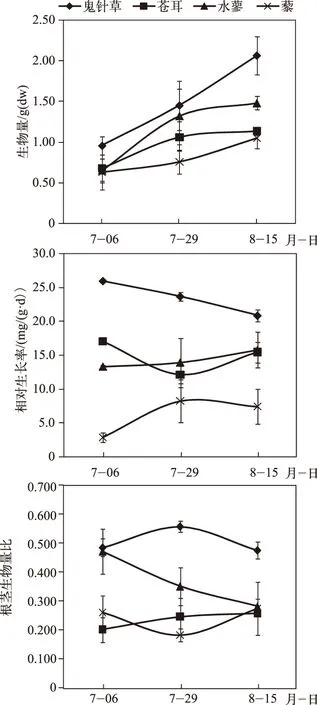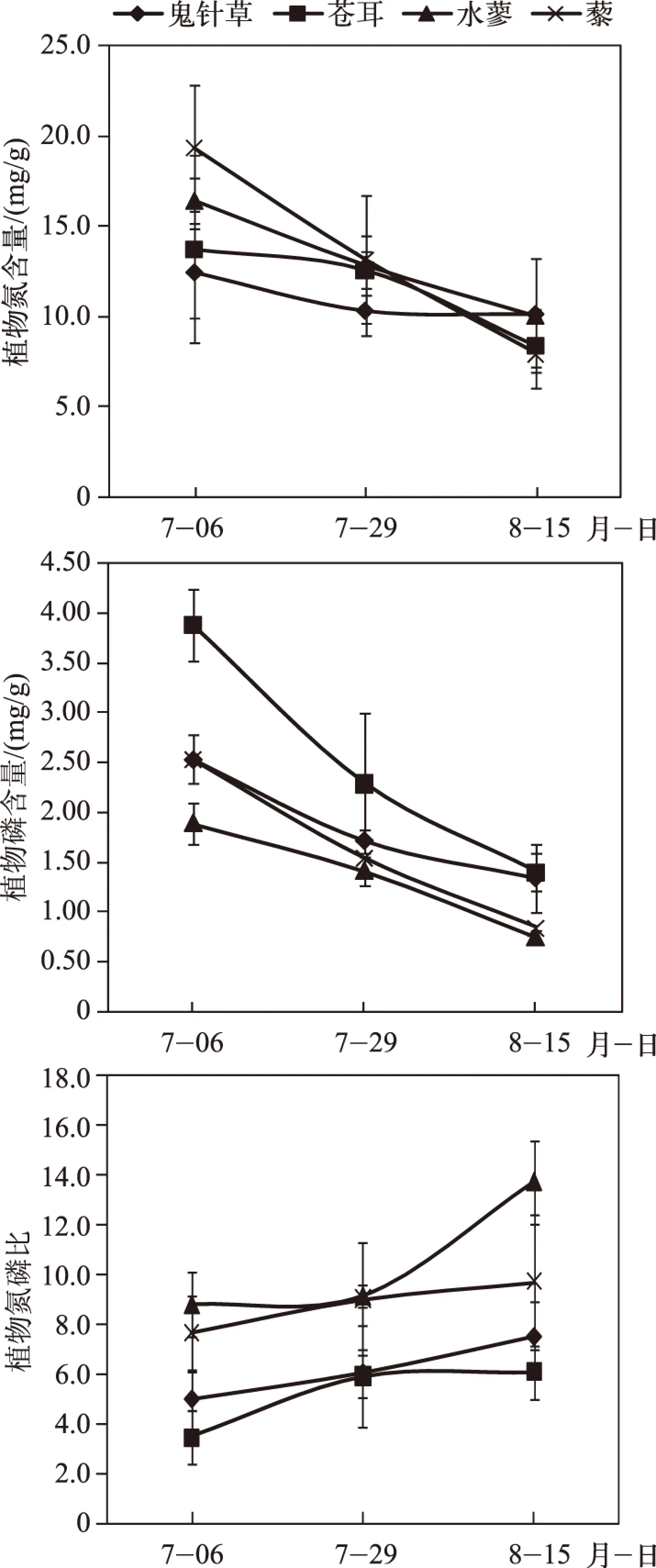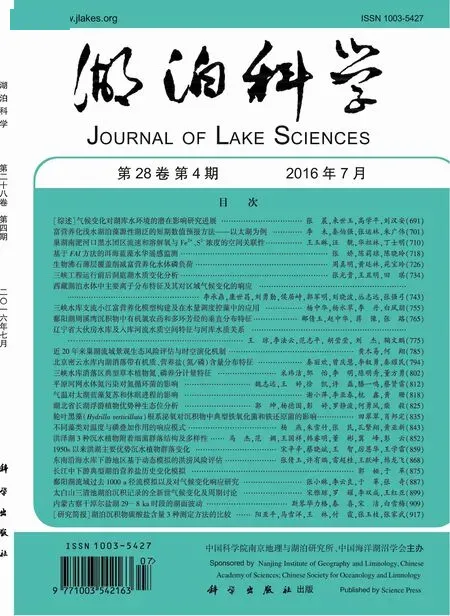三峡水库消落区典型草本植物氮、磷养分计量特征*
2016-09-08米玮洁陈明秀董方勇
米玮洁,邹 怡,李 明,陈明秀,董方勇
(水利部中国科学院水工程生态研究所水利部水工程生态效应与生态修复重点实验室,武汉 430079)
三峡水库消落区典型草本植物氮、磷养分计量特征*
米玮洁,邹怡,李明,陈明秀,董方勇**
(水利部中国科学院水工程生态研究所水利部水工程生态效应与生态修复重点实验室,武汉 430079)
为明确消落区土壤养分对植物生长的影响,通过室内栽培试验,研究三峡库区秭归消落区土壤3种氮磷水平下4种草本植物—鬼针草(Bidenspilosa)、苍耳(Xanthiumsibiricum)、水蓼(Polygonumhydropiper)、藜(Chenopodiumalbum)长势及氮、磷计量特征. 结果表明,消落区土壤中生长的植物氮含量为7.98~19.4 mg/g,磷含量为0.740~3.880 mg/g,氮磷比为3.48~13.70,判别植物生长受氮限制. 外源氮磷的添加促进植物氮、磷含量明显升高,但氮磷比没有明显变化;外源氮磷添加解除植物受氮的限制作用. 4种植物对消落区土壤低氮环境具有一定的适应能力. 比较消落区土壤中4种植物长势,鬼针草生物量、相对生长率、根茎生物量比最高,氮磷养分丰富对鬼针草生长促进作用最明显,表明鬼针草更易于在氮、磷贫乏的三峡库区消落区形成优势群落.
消落区;氮;磷;氮磷比;氮限制;根茎比;三峡水库
水库消落区是指水库调度引起水位变动,使水陆衔接地带的土地被周期性淹没和出露而形成的干湿交替地带,它表现出一定的生态脆弱性. 水库消落区往往存在植被破坏、生物多样性下降、小气候恶化、河床及河岸遭受侵蚀等生态环境问题[1-3]. 从2003年三峡库区完成135 m蓄水目标,到2010年三峡大坝坝前水位达175 m,落差达30 m的水库消落区全部形成. 三峡消落区维管束植物以草本植物为主,且以一年生草本植物居多[4]. 从2001年开始,国内开展一系列三峡消落区植被群落调查工作,研究三峡库区消落区植被的恢复、生长与结构特征、演替过程[5-13]. 消落区淹水时间、土壤湿度和土壤质地是影响植物群落组成和空间分布的主要因子[14]. 三峡消落区不同高程受淹时间由短到长,环境湿度梯度由干燥到湿润,消落区土壤呈现明显的分层结构,植被也呈现明显的分层结构[5-7, 15]. 植物生长过程中,土壤氮磷养分水平及限制作用对植物生长及种间竞争具有重要影响[16-17],进而改变植物群落组成及多样性[18],引起植物群落发生演替[19]. 因此,消落区土壤养分供应影响消落区植物的生长、种群结构及稳定性.
植物营养元素化学特征与环境的关系,反映了植物对环境的适应能力. 植物氮磷生态化学计量特征是植物群落结构和功能的一种内在调控机制[20],是揭示植物养分限制状况及其适应策略的重要手段. 近年来生态化学计量学理论在植物方面的研究与应用主要侧重于:1)植物生长、群落特征与生态化学计量特征的关系;包括植物不同器官[21]、不同生长期[22-23]的生态化学计量特征变化;植物物种多样性[24]、群落演替[25-26]与生态化学计量的关系. 2)环境与植物生态化学计量特征的相互作用:包括土壤[27-28]、施肥[29-30]、放牧[31]等环境因素对植物生态化学计量特征的影响. 也开始关注湿地、河岸带/湖滨带植物的生态化学计量特征[32],主要研究了山地沼泽湿地[33]、湖滨带[34]、河口[35]、潮滩地[36]、滩涂湿地[37]土壤与植物的生态化学计量学特征,但有关消落区植物的养分计量特征、消落区自然恢复的草本植物群落与消落区土壤养分水平相互作用的研究还很少. 植物营养计量学为消落区草本植物生长及竞争关系研究提供了一个新的途径,为揭示三峡库区消落区植物群落变化趋势并为库区生态保护与重建提供科学依据.
为了明确消落区植物对氮磷养分的吸收利用特点,本文以三峡库区消落区天然草本植物群落中的常见种(鬼针草(Bidenspilosa)、苍耳(Xanthiumsibiricum)、水蓼(Polygonumhydropiper)、藜(Chenopodiumalbum))为研究对象,在人工控制氮磷营养水平的条件下,分析植物在不同养分条件下的氮磷化学计量特征,比较4种植物的氮磷吸收特征与生长特征,以期揭示植物的养分利用状况,判断植物生长限制因子和限制程度等,以便探讨其在消落区具有区域性特点生长的养分特征. 旨在研究三峡库区消落区土壤氮磷养分对草本植物生长的影响,为消落区草本植物生长与群落演替提供理论基础.
1 材料与方法
1.1 材料
供试土壤:取自三峡库区缓坡消落区秭归县九曲垴渡口(30°53′N, 110°53′E;海拔160 m). 样地邻近区域年均气温18℃,年均降雨量1100 mm,坡度36°,母岩为花岗岩,土壤类型为黄壤土,土层厚度40 cm左右,植被为人工马尾松(Pinusmassoniana)林. 土壤取回晾干后过3 mm筛,混匀,测定土壤的pH值、有机质含量及氮磷含量(表1).

表1 三峡库区秭归消落区供试土壤基本理化特征
供试植物:根据2009年5-9月在三峡水库消落区出露期间对库区典型干流消落区和库湾消落区植被进行的调查,选择优势植物鬼针草、苍耳、水蓼、藜作为研究对象. 植物幼苗取自三峡库区缓坡消落区兴山县香溪河流域消落区(昭君镇昭君村, 31°15′ N, 110°44′ E;海拔166 m;峡口镇黄家沟,31°10′N, 110°46′E;海拔162 m). 取回实验室后,洗去根系上的土壤,选取长势、生物量稍一致的幼苗,种在装有消落区土壤的盆钵中.
1.2 实验设置
2010年6-9月在三峡大学化学与生命科学学院温室大棚进行消落区植物栽培实验. 根据草本植物盆栽实验研究[38],本文设置3个施肥梯度:N0P0(0 g N/kg土、0 g P2O5/kg土)、N1P1(0.2 g N/kg土、0.2 g P2O5/kg土)、N2P2(0.5 g N/kg土、0.4 g P2O5/kg土). 氮肥选用(NH4)2SO4、磷肥选用Ca(H2PO4)2·H2O. 将固体肥料与土壤拌匀后,装入2 L(盆口直径15 cm)的塑料桶,每个处理9个重复. 2010年6月11日种植植物幼苗,每桶种一株株高稍一致、重量2.5~3.0 g的植物幼苗,每种植物种27盆. 植物生长过程中用量筒添加蒸馏水补充水分. 分别于7月6日、7月29日、8月15日取样,每次取样每个处理3个重复,分别测定植物生物量及氮磷含量.
1.3 测定指标与方法
风干土壤样品、烘干植物样品粉碎后过0.149 mm筛,用于测定分析[39]:土壤有机质含量采用重铬酸钾容量法测定;土壤pH值采用玻璃电极法测定;土壤全氮含量采用K2SO4-CuSO4-Se蒸馏-半微量凯氏法测定;土壤有效氮含量采用碱解扩散法测定;土壤有效磷含量采用0.5 mol/L NaHCO3浸提-钼锑抗比色法测定. 植物样品用H2SO4-H2O2消解后,植物氮含量采用凯氏定氮法测定,植物磷含量采用钼锑抗比色法测定.

图1 三峡水库消落区土壤中植物的生长特征Fig.1 Plant growth in soil of water-level-fluctuation zone of Three Gorges Reservoir
1.4 数据处理
使用SPSS 13.0软件进行数据处理、统计分析:采用单因素方差分析(One-way ANOVA)比较消落区不同植物种类长势、氮磷计量特征的差异;采用单变量多因素方差分析(GLM Univariate)植物种类、采样时间、氮磷水平对植物长势、氮磷计量特征的影响. 方差分析过程中,首先进行方差齐性检验;方差齐性,选择S-N-K进行多重比较;方差非齐性,选择Tamhane’s T2进行多重比较.

图2 三峡水库不同氮磷水平消落区土壤中植物的生长特征(A、B、C表示同一植物不同氮、磷水平差异显著(P<0.05),下图同)Fig.2 Plant growth in soil with different N & P levels of water-level-fluctuation zone of Three Gorges Reservoir
2 结果与分析
2.1 消落区植物的生长特征及对土壤氮磷水平的响应
消落区土壤(N0P0水平)中鬼针草、苍耳、水蓼、藜均长势良好. 4种植物的生物量差异明显(P<0.01):鬼针草生物量最高,其次为水蓼、苍耳,藜生物量最低;不同采样时间植物生物量也表现出明显差异(P<0.01):随着生长,植物生物量明显增加;其中鬼针草生物量增加最明显,其次是水蓼(图1). 4种植物相对生长率差异显著(P<0.01):鬼针草相对生长率最高,其次为水蓼、苍耳,藜相对生长率最低;不同采样时间植物相对生长率差异不明显(P=0.935)(图1). 4种植物根茎生物量比差异明显(P<0.01):鬼针草根茎生物量比最高,其次为水蓼,苍耳、藜根茎生物量比较低;不同采样时间植物根茎生物量比差异不明显(P=0.520)(图1).
比较不同土壤氮磷水平(N0P0、N1P1和N2P2)中消落区植物的长势差异(图2):与N0P0处理相比,N1P1处理中除苍耳生物量(P=0.404)、根茎生物量比(P=0.122)没有明显变化外,其余植物生物量、相对生长率显著增加(P<0.01),根茎生物量比显著降低(P<0.01). 与N1P1处理相比,N2P2处理中除鬼针草相对生长率显著增加(P<0.01)外,其余植物生物量(P=0.501)、相对生长率(P=0.367)、根茎生物量比(P=0.480)均没有显著差异. 4种植物相比,植物生物量、相对生长率差异显著(P<0.01),其中,鬼针草生物量、相对生长率最高,其次为苍耳、水蓼,藜生物量、相对生长率最低;4种植物根茎生物量比没有显著差异(P=0.179).
2.2 消落区植物氮磷计量特征及对土壤氮磷水平的响应
比较消落区土壤(N0P0水平)中4种植物的氮磷含量及氮磷比(图3):消落区土壤中,植物氮含量范围为7.98~19.35 mg/g,4种植物氮含量没有明显差异(P=0.185). 随着生长,植物氮含量明显下降(P<0.01),其中,藜氮含量变化最大,鬼针草氮含量变化最小. 植物磷含量范围为0.74~3.88 mg/g,4种植物磷含量差异显著(P<0.01),苍耳磷含量最高,其次为鬼针草、藜,水蓼磷含量最低. 随着生长,植物磷含量显著下降(P<0.01),其中,苍耳磷含量变化最大,鬼针草磷含量变化最小. 植物氮磷比范围为3.48~13.73,4种植物氮磷比差异显著(P<0.01):水蓼氮磷比最高,其次为藜,苍耳、鬼针草氮磷比较低. 随着植物生长,植物氮磷比明显增加(P<0.01),其中鬼针草氮磷比增加最明显(图3).
比较不同土壤氮磷水平(N0P0、N1P1和N2P2)中消落区植物的氮磷含量、氮磷比(图4):与N0P0处理相比,N1P1处理中消落区植物氮、磷含量显著增加(P<0.01);氮磷比除水蓼显著降低(P<0.01)外,其余植物均没有表现出显著差异(PBid=0.359,PXan=0.106,PChe=0.056). 与N1P1处理相比,N2P2处理中鬼针草氮含量显著增加(P<0.01),水蓼氮含量显著降低(P<0.01),苍耳、藜氮含量均没有显著差异(PXan=0.665,PChe=0.404). 除鬼针草磷含量没有显著变化(P=0.436)外,其余植物磷含量均显著降低(P<0.01). 除苍耳氮磷比显著增加(P<0.01)外,其余植物氮磷比均没有明显变化(PBid=0.093,PPol=0.938,PChe=0.195). 4种植物相比,植物氮含量、磷含量、氮磷比均差异显著(P<0.01),其中,苍耳氮含量最低,水蓼磷含量最低,水蓼氮磷比最高.
3 讨论
3.1 消落区植物生长的限制性因子
三峡库区消落区土壤受水位涨落的影响,土壤物理性状发生改变,土壤养分含量总体呈下降趋势[40]. 郭劲松等调查三峡库区巫山-重庆主城区段消落区土壤,认为三峡消落区有机质、TN含量处于偏低水平[41]. 将本次取样的消落区土壤氮磷含量与2008年整个消落区土壤氮磷含量[42]相比,本次取样消落区土壤的氮磷含量处于较低水平. 与蓄水前三峡水库秭归段库岸土壤养分特征[43]相比,蓄水后秭归消落区土壤氮磷含量明显下降. 这可能与消落区淹水-出露过程有关,消落区土壤经淹水-出露过程后,土壤中氮磷水平明显降低[44]. 此外,植物生长也会对消落区土壤养分产生影响. Ye等研究发现三峡库区消落区植被短期恢复-淹水过程中,土壤无机氮含量明显下降,土壤有机碳以及碳氮比也发生明显变化[45].
三峡库区秭归消落区土壤中生长的鬼针草、苍耳、水蓼、藜氮含量为7.98~19.35 mg/g(<20 mg/g),磷含量为0.74~3.88 mg/g,氮磷比为3.48~13.73(<14). 利用氮磷比作为植物氮磷限制因子的指示,根据Aerts & Chapin[46]和Ellison[47]给出的临界值作为氮磷限制作用的判断标准,三峡库区秭归消落区土壤中4种植物的生长处于氮限制状态. 与其他消落区/河岸带草本植物氮磷含量特征[48]相比,本研究中植物的氮磷含量及氮磷比范围较相近,而且都处于氮限制状态,这可能与淹水-退水过程中,土壤中氮含量下降比磷含量更为明显有关[44]. 消落区土壤氮磷添加后,植物氮磷含量也明显增加,氮含量>20 mg/g,磷含量>1 mg/g. 根据Aerts & Chapin[46]和Ellison[47]给出的临界值判断,此时植物不再受氮限制.

图3 三峡水库消落区土壤中植物的氮磷计量特征Fig.3 N & P stoichiometry characteristics of plant growing in soil of water-level-fluctuation zone of Three Gorges Reservoir

图4 三峡水库不同氮磷水平消落区土壤中植物的氮磷计量特征Fig.4 N & P stoichiometry characteristics of plant growing in soil with different N & P levels of water-level-fluctuation zone of Three Gorges Reservoir
3.2 消落区植物生长的养分利用策略
根据Tilman的竞争资源比理论:在较长的时间里,营养元素含量降低的物种较适于在元素匮乏的地区生长,氮磷含量降低的植物在N-限制或P-限制的环境下会成为优势物种[49]. 一般来说,低氮含量、低N∶P比的植物适应氮限制类型的土壤. 李小峰等通过研究百花湖消落带植物养分元素特征,也认为禾本科、蓼科、菊科植物中的营养元素含量较低,又具有一定的耐水淹性,适宜在消落区水淹时间较长且土壤中氮磷营养元素含量较低的特殊环境下生长[50]. 本研究中,消落区土壤中鬼针草、苍耳、水蓼、藜氮磷含量均较低,而且随着植物生长氮磷含量表现出明显的下降趋势,氮磷比呈增加趋势,这是消落区4种优势草本植物对消落区土壤低氮环境的适应,通过降低磷吸收,增加氮磷比,缓解氮限制作用.
在三峡库区秭归消落区土壤中,虽然判断鬼针草、苍耳、水蓼、藜均处于氮限制,但这4种植物长势良好,其中鬼针草长势最好,表现为鬼针草生物量最高、相对生长率最高,根茎生物量比也最高. 在生长过程中,鬼针草向根系分配的生物量比例明显高于其他3种植物,这可能是鬼针草在氮限制的消落区土壤中长势最好的原因之一. 植物生长过程中根茎生物量比变化是对环境养分的一种适应策略. 例如,环境低氮水平时,植物会增加吸收器官的生物量分配,有利于养分吸收;环境高氮水平时,植物将更多的生物量投入同化器官,有利于碳积累[51]. 氮限制时,植物根系分配的生物量越多,表明其对氮的竞争作用越强[18]. 因此,三峡库区消落区植物在氮限制条件下,鬼针草根系生长的能力更强,向根系分配更多生物量,进而促进鬼针草对氮的吸收.
外源养分丰富会促进植物生长,增加植物株高、叶片或茎条数、生物量,降低植物根系生物量比[51-52]. 本研究中土壤氮磷添加促使植物生物量、相对生长率明显增加,根茎生物量比明显降低. 因此,土壤氮磷丰富对消落区植物生长的影响表现在:1)促进植物生长、生物量的累积,2)减少植物生物量向根系分配. 当氮素不再是植物生长的限制因子时,植物会分配更多的生物量到碳同化器官,促进地上部分生长,使总生物量升高,有助于提高植株的竞争能力[18],养分增加对植物生长的促进效应越强则植物在竞争中往往处于优势. 本研究中,土壤氮磷养分增加后,鬼针草生物量、相对生长率均最高,表明相较于其他植物而言,鬼针草对养分利用更具有优势,养分丰富对鬼针草生长的促进作用更明显.
消落区土壤氮磷丰富明显促进消落区植物氮磷含量增加,但植物氮磷比没有明显变化,这是植物养分计量内稳性的一种表现. 消落区土壤中,植物氮磷比范围为4.95~15.60;土壤氮磷含量增加后,植物氮磷比范围为4.47~11.50. 因此,即使土壤中氮磷添加后,促进植物体内氮磷含量增加,但是由于植物自身的内稳性调节,使得氮磷比保持在一定范围内.
综上,三峡库区秭归消落区土壤氮限制条件下,这4种优势植物对土壤低氮缓解具有一定的适应能力. 相较之下,鬼针草在消落区土壤中长势最好,具有更高的根茎生物量比;而且当土壤氮磷养分添加后,对鬼针草生长促进作用最明显. 因此,与苍耳、水蓼、藜相比,鬼针草对消落区土壤氮磷养分利用能力更强,在三峡库区消落区更容易成为优势种.
[1]Fan Xiaohua, Xie Deti, Wei Chaofu. Study on countermeasures for ecological environmental protection and utilization of riparian zone of Three Gorge Reservoir.JournalofSoilandWaterConservation, 2006, 20(2): 165-169(in Chinese with English abstract). [范小华, 谢德体, 魏朝富. 三峡水库消落区生态环境保护与利用对策研究. 水土保持学报, 2006, 20(2): 165-169.]
[2]Su Weici, Zhao Chunyong, Yang Hua. Evaluation on natural conditions of water-level-fluctuating zone(WLFZ) in Three-Gorge Reservoir.ScientiaGeographicaSinica, 2009, 29(2): 268-272(in Chinese with English abstract). [苏维词, 赵纯勇, 杨华. 三峡库区消落区自然条件及其开发利用评价——以重庆库区为例. 地理科学, 2009, 29(2): 268-272.]
[3]Liu Weiwei, Wang Jie, Wang Yongetal. The differences of plant community diversity among the different altitudes in the water-level-fluctuating zone of the Three Gorges Reservoir.ActaEcologicaSinica, 2012, 32(17): 5454-5466(in Chinese with English abstract). DOI 10.5846/stxb201102240211. [刘维暐, 王杰, 王勇等. 三峡水库消落区不同海拔高度的植物群落多样性差异. 生态学报, 2012, 32(17): 5454-5466.]
[4]Liu Weiwei, Yang Fan, Wang Jieetal. Plant species dynamic distribution in the water-level-fluctuating zone of the Main Stream and Bay of the Three Gorges Reservoir.PlantScienceJournal, 2011, 29(3): 296-306(in Chinese with English abstract). DOI 10.3724/SP.J.1142.2011.30296. [刘维暐, 杨帆, 王杰等. 三峡水库干流和库湾消落区植被物种动态分布研究. 植物科学学报, 2011, 29(3): 296-306.]
[5]Wang Yong, Li Enhua, Wu Jinqing. A preliminary study on the vascular plant flora of the water-level-fluctuating zone in the Three-Gorge Reservoir area.JournalofWuhanBotanicalResearch, 2002, 20(4): 265-274(in Chinese with English abstract). [王勇, 厉恩华, 吴金清. 三峡库区消涨带维管植物区系的初步研究. 武汉植物学研究, 2002, 20(4): 265-274.]
[6]Wang Yong, Wu Jinqing, Huang Hongwenetal. Quantitative analysis of plant communities in water-level-fluctuation zone within Three Gorges Reservoir area of Changjiang River.JournalofWuhanBotanicalResearch, 2004, 22(4): 307-314(in Chinese with English abstract). [王勇, 吴金清, 黄宏文等. 三峡库区消涨带植物群落的数量分析. 武汉植物学研究, 2004, 22(4): 307-314.]
[7]Feng Yilong, Xian Xudong, Wang Haiyang. Distribution patterns of plant communities in the riparian zones in Chongqing and forecasting of the characteristics of their succession after inundation.JournalofSouthwestChinaNormalUniversity(NaturalScience), 2007, 32(5): 112-117(in Chinese with English abstract). [冯义龙, 先旭东, 王海洋. 重庆市区消落带植物群落分布特点及淹水后演替特点预测. 西南师范大学学报: 自然科学版, 2007, 32(5): 112-117.]
[8]Yang Chaodong, Zhang Xia, Xiang Jiayun. Plant communities and distribution patterns in riparian zones of Three Gorge Reservoir area.JournalofAnhuiAgricultralScience, 2008, 36(31): 13795-13796, 13866(in Chinese with English abstract). [杨朝东, 张霞, 向家云. 三峡库区消落带植物群落及分布特点的调查. 安徽农业科学, 2008, 36(31): 13795-13796, 13866.]
[9]Wang Qiang, Yuan Xingzhong, Liu Hongetal. Plant communities in newly created wetlands in water-level fluctuation zone of Three-Gorges Reservoir after flooding to 156m height.ChineseJournalofEcology, 2009, 28(11): 2183-2188(in Chinese with English abstract). [王强, 袁兴中, 刘红等. 三峡水库156m蓄水后消落带新生湿地植物群落. 生态学杂志, 2009, 28(11): 2183-2188.]
[10]Xia Zhiyong. The distributing characters of plant species and plant community diversity in the water-level-fluctuating zone of the Three Gorges Reservoir [Dissertation]. Chongqing: Southwest University, 2011(in Chinese with English abstract). [夏智勇. 重庆三峡水库消落带植物分布特征与群落物种多样性研究[学位论文]. 重庆:西南大学, 2011.]
[11]Zhang Zhiyong, Liu Mingqin, Zheng Zhiweietal. Plant diversity in water-level-fluctuation zone of Xiaojiang watershed in Three Gorges Reservoir.JournalofHydroecology, 2011, 32(3): 38-42(in Chinese with English abstract). [张志永, 刘明芹, 郑志伟等. 三峡水库小江流域消落区的植物多样性研究. 水生态学杂志, 2011, 32(3): 38-42.]
[12]Li Bo, Xiong Sen, Huang Yazhouetal. Changing patterns of plant communities in the drawdown zone of Baijia Creek under the influence of Three Gorges Reservoir impoundment.JournalofChongqingNormalUniversity(NaturalScience), 2012, 29(3): 70-74(in Chinese with English abstract). DOI 10.11721/cqnuj20120314. [李波, 熊森, 黄亚洲等. 三峡水库蓄水对白夹溪消落区的植物群落格局的影响. 重庆师范大学学报: 自然科学版, 2012, 29(3): 70-74.]
[13]Lei Bo, Wang Yechun, You Yongfeietal. Diversity and structure of herbaceous plant community in typical water-level-fluctuation zone with different spacing elevations in Three Gorges Reservoir.JLakeSci, 2014, 26(4): 600-606(in Chinese with English abstract). DOI 10.18307/2014.0415. [雷波, 王业春, 由永飞等. 三峡水库不同间距高程消落带草本植物群落物种多样性与结构特征. 湖泊科学, 2014, 26(4): 600-606.]
[14]Sun Rong. Study on riparian plant of mountain river—Pengxi River of Three Gorges Reservoir area as a case study[Dissertation]. Chongqing: Chongqing University, 2010(in Chinese with English abstract). [孙荣. 山地河流河岸植被生态学研究——以三峡库区澎溪河为例[学位论文]. 重庆:重庆大学, 2010.]
[15]Wang Yechun, Lei Bo, Zhang Sheng. Differences in vegetation and soil characteristics at different water-level altitudes in the drawdown areas of Three Gorges Reservoir area.JLakeSci, 2012, 24(2): 206-212(in Chinese with English abstract). DOI 10.18307/2012.0206. [王业春, 雷波, 张晟. 三峡库区消落带不同水位高程植被和土壤特征差异. 湖泊科学, 2012, 24(2): 206-212.]
[16]Zhao Congjiao, Deng Zifa, Zhou Changfangetal. Effects of nitrogen availability and competition on leaf characteristics ofSpartinaalternifloraandPhragmitesaustralis.ChineseJournalofPlantEcology, 2008, 32(2): 392-401(in Chinese with English abstract). DOI 10.3773/j.issn.1005-264x.2008.02.017. [赵聪蛟, 邓自发, 周长芳等. 氮水平和竞争对互花米草与芦苇叶特征的影响. 植物生态学报, 2008, 32(2): 392-401.]
[17]Venterink HO, Güsewell S. Competitive interactions between two meadow grasses under nitrogen and phosphorus limitation.FunctionalEcology, 2010, 24(4): 877-886.
[18]Tian Yaohua, Feng Yulong, Liu Chao. Effects of nitrogen fertilization and planting density onAgeratinaadenophoragrowth and its competitive traits.ChineseJournalofEcology, 2009, 28(4): 577-588(in Chinese with English abstract). [田耀华, 冯玉龙, 刘潮. 氮肥和种植密度对紫茎泽兰生长和竞争的影响. 生态学杂志, 2009, 28(4): 577-588.]
[19]Portielje R, Roijackers RMM. Primary succession of aquatic macrophytes in experimental ditches in relation to nutrient input.AquaticBotany, 1995, 50: 127-140.
[20]Yu Q, Chen Q, Elser JJetal. Linking stoichiometric homoeostasis with ecosystem structure, functioning and stability.EcologyLetters, 2010, 13: 1390-1399.
[21]Zhao Yafang, Xu Fuli, Wang Weilingetal. Seasonal variation in contents of C, N and P and stoichiometry characteristics in fine roots, stems and needles ofLarixprincipis-rupprechtii.ChineseBulletinofBotany, 2014, 49(5): 560-568(in Chinese with English abstract). DOI 10.3724/SP.J.1259.2014.00560. [赵亚芳, 徐福利, 王渭玲等. 华北落叶松根茎叶碳氮磷含量及其化学计量学特征的季节变化. 植物学报, 2014, 49(5): 560-568.]
[22]Xiao Yao, Tao Ye, Zhang Yuanming. Biomass allocation and leaf stoichiometric characteristics in four desert herbaceous plants during different growth periods in the Gurbantünggüt Desert, China.ChineseJournalofPlantEcology, 2014, 38(9): 929-940(in Chinese with English abstract). DOI 10.3724/SP.J.1258.2014.00087. [肖遥, 陶冶, 张元明. 古尔班通古特沙漠4种荒漠草本植物不同生长期的生物量分配与叶片化学计量特征. 植物生态学报, 2014, 38(9): 929-940.]
[23]Yang Mei, Wang Changquan, Yuan Dagangetal. C, N, P stoichiometry traits of different flue-cured tobacco organs at different growth stages.ChineseJournalofEco-Agriculture, 2015, 23(6): 686-693(in Chinese with English abstract). DOI 10.13930/j.cnki.cjea.141289. [杨梅, 王昌全, 袁大刚等. 不同生长期烤烟各器官C、N、P生态化学计量学特征. 中国生态农业学报, 2015, 23(6): 686-693.]
[24]Chen Junqiang, Zhang Rui, Hou Yaochenetal. Relationships between species diversity and C, N and P ecological stoichiometry in plant communities of sub-alpine meadow.ChineseJournalofPlantEcology, 2013, 37(11): 979-987(in Chinese with English abstract). DOI 10.3724/SP.J.1258.2013.00101. [陈军强, 张蕊, 侯尧宸等. 亚高山草甸植物群落物种多样性与群落C、N、P生态化学计量的关系. 植物生态学报, 2013, 37(11): 979-987.]
[25]Yan Bangguo, He Guangxiong, Li Jichaoetal. Changes of plant leaf N, P, and K concentrations and species dominance in an arid-hot valley after ecosystem restoration.ChineseJournalofAppliedEcology, 2013, 23(4): 956-960(in Chinese with English abstract). [闫帮国, 何光熊, 李纪潮等. 生态系统恢复后干热河谷植物叶片N、P、K含量及物种优势度的变化. 应用生态学报, 2013, 23(4): 956-960.]
[26]Lin Li, Li Yikang, Zhang Faweietal. Soil nitrogen and phosphorus stiochiometry in a degradation series ofKobresiahumulismeadows in the Tibetan Plateau.ActaEcologicaSinica, 2013, 33(17): 5245-5251(in Chinese with English abstract). DOI 10.5846/stxb201205310797. [林丽, 李以康, 张法伟等. 高寒矮嵩草群落退化演替系列氮磷生态化学计量学特征. 生态学报, 2013, 33(17): 5245-5251.]
[27]Yang Jiajia, Zhang Xiangru, Ma Lushaetal. Ecological stoichiometric relationships between components ofRobiniapseudoacaciaforest in Loess Plateau.ActaPedologicaSinica, 2014, 51(1): 133-142(in Chinese with English abstract). DOI 10.11766/trxb201211280492. [杨佳佳, 张向茹, 马露莎等. 黄土高原刺槐林不同组分生态化学计量关系研究. 土壤学报, 2014, 51(1): 133-142.]
[28]Li Congjuan, Lei Jiaqiang, Xu Xinwenetal. The stoichiometric characteristics of C, N, P for artificial plants and soil in the hinterland of Taklimakan Desert.ActaEcologicaSinica, 2013, 33(18): 5760-5767(in Chinese with English abstract). DOI 10.5846/stxb201304300872. [李从娟, 雷加强, 徐新文等. 塔克拉玛干沙漠腹地人工植被及土壤CNP的化学计量特征. 生态学报, 2013, 33(18): 5760-5767.]
[29]Lin Xinjian, Wang Fei, Wang Changfangetal. Effects of long-term fertilization on weed community characteristics and carbon, nitrogen and phosphorus stoichiometry during winter-spring season in yellow-clay paddy fields of South China.ChineseJournalofEco-Agriculture, 2012, 20(5): 573-577(in Chinese with English abstract). DOI 10.3724/SP.J.1011.2012.00573. [林新坚, 王飞, 王长方等. 长期施肥对南方黄泥田冬春季杂草群落及其C、N、P化学计量的影响. 中国生态农业学报, 2012, 20(5): 573-577.]
[30]Bin Zhenjun, Wang Jingjing, Zhang Wenpengetal. Effects of N addition on ecological stoichiometric characteristics in six dominant plant species of alpine meadow on the Qinghai-Xizang Plateau, China.ChineseJournalofPlantEcology, 2014, 38(3): 231-237(in Chinese with English abstract). DOI 10.3724/SP.J.1258.2014.00020. [宾振均, 王静静, 张文鹏等. 氮肥添加对青藏高原高寒草甸6个群落优势种生态化学计量学特征的影响. 植物生态学报, 2014, 38(3): 231-237.]
[31]Ding Xiaohui, Gong Li, Wang Dongboetal. Grazing effects on eco-stoichiometry of plant and soil in Hulunbeir, Inner Mogolia.ActaEcologicaSinica, 2012, 32(15): 4722-4730(in Chinese with English abstract). DOI 10.5846/stxb201104200523. [丁小慧, 宫立, 王东波等. 放牧对呼伦贝尔草地植物和土壤生态化学计量学特征的影响. 生态学报, 2012, 32(15): 4722-4730.]
[32]Hu Weifang, Zhang Wenlong, Zhang Linhaietal. Stoichiometric characteristics of nitrogen and phosphorus in major wetland vegetation of China.ChineseJournalofPlantEcology, 2014, 38(10): 1041-1052(in Chinese with English abstract). DOI 10.3724/SP.J.1258.2014.00098. [胡伟芳, 章文龙, 张林海等. 中国主要湿地植被氮和磷生态化学计量学特征. 植物生态学报, 2014, 38(10): 1041-1052.]
[33]Xiao Ye, Shang Lina, Huang Zhigangetal. Ecological stoichiometry characteristics of soil carbon, nitrogen and phosphorus in mountain swamps of Eastern Jilin Province.ScientiaGeographicaSinica, 2014, 34(8): 994-1001(in Chinese with English abstract). [肖烨, 商丽娜, 黄志刚等. 吉林东部山地沼泽湿地土壤碳氮磷含量及其生态化学计量学特征. 地理科学, 2014, 34(8): 994-1001.]
[34]Bao Han, Qing Hua, Wang Lixinetal. A study on ecological stoichiometry of plant on lakeside zone of Lake Wuliangsuhai.JournalofInnerMongoliaUniversity(NaturalScienceEdition), 2014, 45(4): 404-409(in Chinese with English abstract). DOI 10.13484/j.nmgdxxbzk.20140412. [包菡, 清华, 王立新等. 乌梁素海湖滨带植物生态化学计量学研究. 内蒙古大学学报: 自然科学版, 2014, 45(4): 404-409.]
[35]Wang Weiqi, Wang Chun, Zeng Congshengetal. Soil carbon, nitrogen and phosphorus ecological stoichiometry ofPhragmitesaustraliswetlands in different reaches in Minjiang River estuary.ActaEcologicaSinica, 2012, 32(13): 4087-4093(in Chinese with English abstract). DOI 10.5846/stxb201106160817. [王维奇, 王纯, 曾从盛等. 闽江河口不同河段芦苇湿地土壤碳氮磷生态化学计量学特征. 生态学报, 2012, 32(13): 4087-4093.]
[36]Liu Wenlong, Xie Wenxia, Zhao Quanshengetal. Spatial distribution and ecological stoichiometry characteristics of carbon, nitrogen and phosphorus in soil inPhragmitesaustralistidal flat of Jiaozhou Bay.WetlandScience, 2014, 12(3): 362-368(in Chinese with English abstract). DOI 10.13248/j.cnki.wetlansci.2014.03.014. [刘文龙, 谢文霞, 赵全升等. 胶州湾芦苇潮滩土壤碳、氮和磷分布及生态化学计量学特征. 湿地科学, 2014, 12(3): 362-368.]
[37]Han Hua, Wang Haobin, Yu Huaguangetal. Ecological stoichiometry of carbon, nitrogen and phosphorus ofPhragmitesaustralispopulation under soil salinity gradients in Chongming wetlands.ResourcesandEnvironmentintheYangtzeBasin, 2015, 24(5): 817-823(in Chinese with English abstract). DOI 10.11870/cjlyzyyhj201505014. [韩华, 王昊彬, 余华光等. 崇明滩涂湿地不同盐度梯度下芦苇种群及土壤的生态化学计量学特征. 长江流域资源与环境, 2015, 24(5): 817-823.]
[38]Liu Dahui. Study on the effects of mineral nutrition and its mechanism in the growth, secondary metabolism and quality of the medicinal plantChrysanthemummorifolium(Ramat.) [Dissertation]. Wuhan: Huazhong Agricultural University, 2007(in Chinese with English abstract). [刘大会. 矿质营养对药用菊花生长、次生代谢和品质的影响及其作用机理研究[学位论文]. 武汉:华中农业大学, 2007.]
[39]Soil chemistry specialty committee of Soil Science Society of China ed. Conventional method of soil and agricultural chemistry analysis. Beijing: Science Press, 1983(in Chinese). [中国土壤学会农业化学专业委员会编. 土壤农业化学常规分析方法. 北京:科学出版社, 1983.]
[40]Kang Yi. The research of soil physical and chemical properties and vegetations dynamics changes in Three Gorges Reservoir hydro-fluctuation belt [Dissertation]. Beijing: Chinese Academy of Forestry, 2010(in Chinese with English abstract). [康义. 三峡库区消落带土壤理化性质和植被动态变化研究[学位论文]. 北京:中国林业科学研究院, 2010.]
[41]Guo Jinsong, Huang Xuanmin, Zhang Binetal. Distribution characteristics of organic matter and total nitrogen in the soils of water-level-fluctuating zone of Three Gorges Reservoir area.JLakeSci, 2012, 24(2): 213-219(in Chinese with English abstract). DOI 10.18307/2012.0207. [郭劲松, 黄轩民, 张彬等. 三峡库区消落带土壤有机质和全氮含量分布特征. 湖泊科学, 2012, 24(2): 213-219.]
[42]He Yang. Investigation of soil nitrogen and phosphorus in water fluctuation zone in central distract of Three Gorges Reservoir area and analysis of its release potential [Dissertation]. Chongqing: Chongqing University, 2009(in Chinese with English abstract). [贺阳. 三峡库区腹心地带消落区土壤氮磷含量调查及其释放潜力分析[学位论文]. 重庆:重庆大学, 2009.]
[43]Ye Chen, Cheng Xiaoli, Zhang Quanfa. Characteristics of soil nutrient distribution in the water-level-fluctuation zone in the Three Gorges Reservoir, China.ChineseJournalofSoilScience, 2011, 42(6): 1404-1410(in Chinese with English abstract). [叶琛, 程晓莉, 张全发. 三峡库区消落区蓄水前土壤养分分布特征. 土壤通报, 2011, 42(6): 1404-1410.]
[44]Guo Quanshui, Kang Yi, Zhao Yujuanetal. Changes in the contents of N, P, K, pH and organic matter of the soil which experienced the hydro-fluctuation in the Three Gorges Reservoir.ScientiaSilvaeSinicae, 2013, 48(3): 7-10(in Chinese with English abstract). DOI 10.11707/j.1001-7488.10120302. [郭泉水, 康义, 赵玉娟等. 三峡库区消落带土壤氮磷钾、pH值和有机质变化. 林业科学, 2013, 48(3): 7-10.]
[45]Ye C, Cheng X, Zhang Yetal. Soil nitrogen dynamics following short-term revegetation in the water level fluctuation zone of the Three Gorges Reservoir, China.EcologicalEngineering, 2012, 38: 37-44.
[46]Aerts R, Chapin III FS. The mineral nutrition of wild plants revisited: a re-evaluation of processes and patterns.AdvancesinEcologicalResearch, 1999, 30: 1-67.
[47]Ellison AM. Nutrient limitation and stoichiometry of carnivorous plants.PlantBiology, 2006, 8: 740-747.[48]Yu Shuai, Chen Wei, He Xingyuanetal. Nitrogen and phosphorus contents of six herb species in riparian zone of Hunhe River, Northeast China.ChineseJournalofEcology, 2012, 31(11): 2775-2780(in Chinese with English abstract). [于帅, 陈玮, 何兴元等. 浑河河岸带六种草本植物氮、磷含量特征. 生态学杂志, 2012, 31(11): 2775-2780.]
[49]Tilman D. Resource competition and community structure. Princeton: Princeton University Press, 1982: 139-177.
[50]Li Xiaofeng, Li Qiuhua, Qin Haolietal. Distribution characteristics of N, P and K contents in 30 common plants from the hydro-fluctuation belt of Baihua Reservoir.ActaScientiaeCircumstantiae, 2013, 33(4): 1089-1097(in Chinese with English abstract). DOI 10.13671/j.hjkxxb.2013.04.033. [李小峰, 李秋华, 秦好丽等. 百花湖消落带常见植物氮磷钾营养元素含量分布特征研究. 环境科学学报, 2013, 33(4): 1089-1097.]
[51]Wang Manlian, Feng Yulong. Effects of soil nitrogen levels on morphology, biomass allocation and photosynthesis inAgeratinaadenophoraandChromoleanaodorata.ChineseJournalofPlantEcology, 2005, 29(5): 697-705(in Chinese with English abstract). DOI 10.17521/cjpe.2005.0093. [王满莲, 冯玉龙. 紫茎泽兰和飞机草的形态、生物量分配和光合特性对氮营养的响应. 植物生态学报, 2005, 29(5): 697-705.]
[52]Marler RJ, Stormberg JC, Patten DT. Growth response ofPopulusfremontii,Salixgooddingii, andTamarixramosissimaseedlings under different nitrogen and phosphorus concentrations.JournalofAridEnvironments, 2001, 49: 133-146.
Nitrogen and phosphorus stoichiometry characteristics of typical herb plants in the water-fluctuation-zone of Three Gorges Reservoir
MI Weijie, ZOU Yi, LI Ming, CHEN Mingxiu & DONG Fangyong**
(KeyLaboratoryofEcologicalImpactsofHydraulic-ProjectsandRestorationofAquaticEcosystemofMinistryofWaterResources,InstituteofHydroecology,MinistryofWaterResourcesandChineseAcademyofSciences,Wuhan430079,P.R.China)
Nitrogen (N) and phosphorus (P) availability limit plant growth in most terrestrial ecosystems. Plastic responses of plants to N and P supply cause variation in biomass and N/P ratios, associated with differences in root allocation, nutrient uptake, biomass turnover and reproductive output. We investigated the growth characteristics and nutrients acquirement of four dominant herb plant species (Bidenspilosa,Xanthiumsibiricum,Polygonumhydropiper, andChenopodiumalbum) sampled from Zigui water-fluctuation-zone of Three Gorges Reservoir by pots cultivation at three N and P levels. In the process of plant growth, we determined plant biomass and nutrient contents of plant tissues. N contents of plant growing in soil ranged in 7.98-19.4 mg/g, and P, ranged in 0.740-3.880 mg/g, and N/P, ranged in 3.48-13.70, which indicated that plants were under N limitation. After N & P supply, N and P contents increased significantly, and plant growth were not limited by N. By comparing the growth characteristics of 4 plant species in soil, the following results were obtained.B.pilosahad significant higher biomass, relative growth rate and root/shoot biomass ratio. After N & P supply,B.pilosagrowth were promoted significantly.B.pilosawould be dominant community in soil of poor nutrient level in water-fluctuation-zone of Three Gorges Reservoir.
Water-fluctuation-zone; nitrogen; phosphorus; N/P ratio; nitrogen limitation; root/shoot biomass ratio; Three Gorges Reservoir
*国家水体污染控制与治理科技重大专项(2009ZX07104-003-04)资助.2015-06-18收稿;2015-10-26收修改稿.米玮洁(1980~),女,博士,助理研究员;E-mail: miweijie@mail.ihe.ac.cn.
**通信作者;E-mail: dfy1008@mail.ihe.ac.cn.
